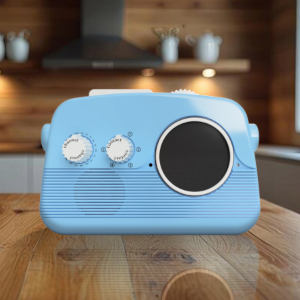Emily's Master's design project tackles a crucial challenge: supporting people with dementia to maintain independence in the kitchen. Moving beyond intrusive smart monitoring, the student developed an assistive product disguised as a familiar, retro-style radio. This prototype uses integrated sensors and timely audio prompts to guide users through complex cooking steps, blending inclusive design and empathy to offer discreet support and preserve user dignity.
The Mole Agent inspired my project.
The design explores the loneliness and daily struggles faced by the elderly residents of a care home. It made me wonder how I could apply my design knowledge to address a challenge faced by seniors.
As my thinking developed, I became particularly interested in supporting older people with dementia (PwD), helping them to independently achieve an everyday task – like cooking.
Cooking involves many sequential steps that require attention and memory. For PwD, losing track of these actions can lead to confusion and even accidents. I wanted to design a product that doesn’t rob them of their sense of independence but offers support by monitoring and prompting their progress.
An extensive review of information about smart home design for PwD made me realise that many solutions focus on simply monitoring user activity rather than understanding their emotional and practical needs.
I decided that my product would support PwD through a prompting system and take a familiar form – an object that feels homely instead of obviously being a piece of medical or assistive technology.
In terms of look, something resembling a retro-styled radio struck me as ideal. Being an everyday and recognisable object, PwD would be less likely to feel confused or panicked when sound comes out of it.
What was the most significant challenge in arriving at this specific design solution?
Arriving at this design solution took some time, but my postgraduate studies gave me the structure and freedom to turn a broad social observation into a specific, tangible design challenge.
I began by organising design guidelines based on research into dementia-friendly and inclusive design principles. These helped me define key priorities such as user familiarity, prompting and reminding systems, social interactions and independence.
My research amassed a lot of different ideas and possible approaches. My fabulous tutor, Dr George Torrens, guided me through the process of analysing this wealth of data to define my concept – and peer discussions provided valuable perspectives that helped me further refine my thinking.
My next task was to explore the form and function of my product. I worked on sketches and low-fidelity prototypes, testing different ways to integrate monitoring and prompting features into my retro-radio inspired design.
Eventually, I was ready to develop and test a functional prototype. This part of my project taught me how to connect technical systems with design thinking – and I gained a deeper understanding of inclusive design principles.
The School’s electronics, multi-material and 3D printing workshops provided everything I needed – and the technical tutors were a huge help, giving me plenty of vital support.
How did you integrate technical systems into the design?
I used the open-source electronics platform Arduino to develop my product’s interactive functions and integrate sensors such as Passive Infrared (PIR) sensors and sound modules for monitoring and prompting. I then used 3D printing to create the shell and enhance the ergonomic performance of the control knob.
Alongside making the prototypes, I undertook bench testing, surveys and peer in-person user testing to evaluate usability and social acceptance. This helped me to validate my concept and refine the design.
Unfortunately, I wasn’t able to work with older users or health and social care professionals.
What specific insight do you feel was missed by not being able to test with older users?
Their experience and expertise would have been invaluable in helping me better understand the daily challenges faced by PwD.
I am happy with my final outcome. The product effectively guides users through specific cooking tasks, focusing on clear sequencing and timely reminders. Its familiar appearance makes it sit comfortably and reassuringly in a kitchen.
What key takeaway would you like other designers to gain from your project?
More broadly, I hope it helps other designers to see that inclusive design is not just about accessibility, but about empathy and dignity. Good design can quietly support independence without taking control away.
I’d love to continue developing this project by improving the prototype and exploring collaborations with healthcare professionals to test it in real settings. Longer term, I want to keep working in the field of inclusive design and assistive technology – applying what I have learnt to help people of all abilities to live full and independent lives.
Visit the School of Design and Creative Arts' Postgraduate Showcase 2025 to explore more designs like this.
